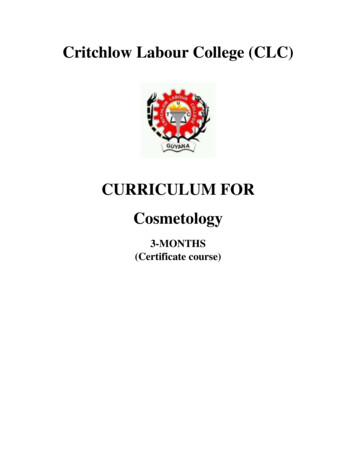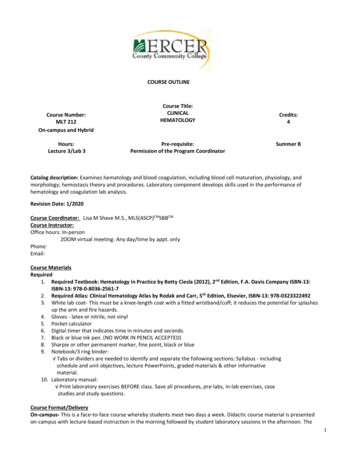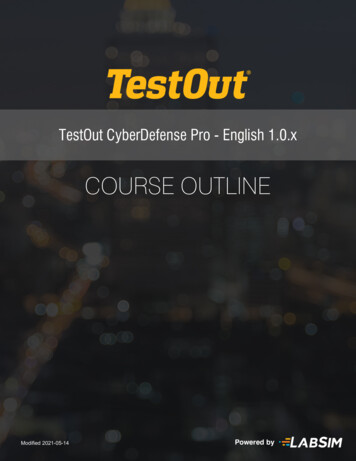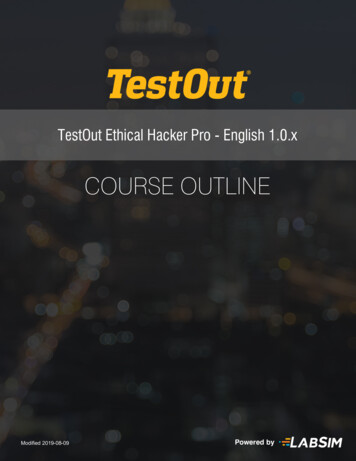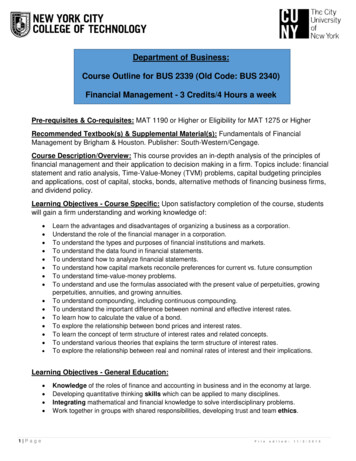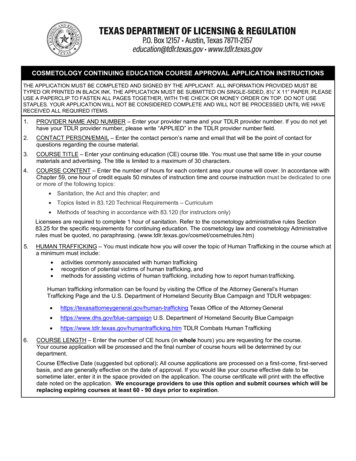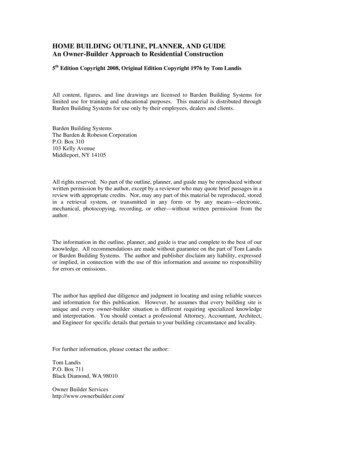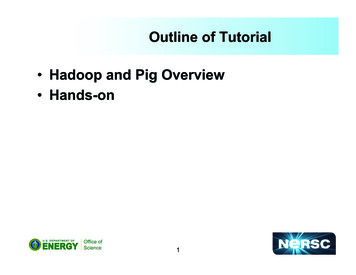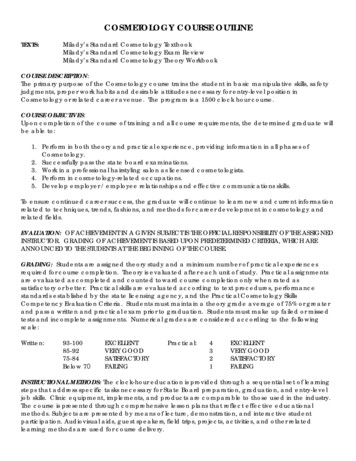
Transcription
COSMETOLOGY COURSE OUTLINETEXTS:Milady’s Standard Cosmetology TextbookMilady’s Standard Cosmetology Exam ReviewMilady’s Standard Cosmetology Theory WorkbookCOURSE DESCRIPTION:The primary purpose of the Cosmetology course trains the student in basic manipulative skills, safetyjudgments, proper work habits and desirable attitudes necessary for entry-level position inCosmetology or related career avenue. The program is a 1500 clock hour course.COURSE OBJECTIVES:Upon completion of the course of training and all course requirements, the determined graduate willbe able to:1. Perform in both theory and practical experience, providing information in all phases ofCosmetology.2. Successfully pass the state board examinations.3. Work in a professional hairstyling salon as licensed cosmetologists.4. Perform in cosmetology-related occupations.5. Develop employer / employee relationships and effective communications skills.To ensure continued career success, the graduate will continue to learn new and current informationrelated to techniques, trends, fashions, and methods for career development in cosmetology andrelated fields.EVALUATION: OF ACHIEVEMENT IN A GIVEN SUBJECT IS THE OFFICIAL RESPONSIBILITY OF THE ASSIGNEDINSTRUCTOR. GRADING OF ACHIEVEMENT IS BASED UPON PREDETERMINED CRITERIA, WHICH AREANNOUNCED TO THE STUDENTS AT THE BEGINNING OF THE COURSE.GRADING: Students are assigned theory study and a minimum number of practical experiencesrequired for course completion. Theory is evaluated after each unit of study. Practical assignmentsare evaluated as completed and counted toward course completion only when rated assatisfactory or better. Practical skills are evaluated according to text procedures, performancestandards established by the state licensing agency, and the Practical Cosmetology SkillsCompetency Evaluation Criteria. Students must maintain a theory grade average of 75% or greaterand pass a written and practical exam prior to graduation. Students must make up failed or missedtests and incomplete assignments. Numerical grades are considered according to the followingscale:Written:93-10085-9275-84Below 70EXCELLENTVERY GOODSATISFACTORYFAILINGPractical:4321EXCELLENTVERY GOODSATISFACTORYFAILINGINSTRUCTIONAL METHODS: The clock-hour education is provided through a sequential set of learningsteps that address specific tasks necessary for State Board preparation, graduation, and entry-leveljob skills. Clinic equipment, implements, and products are comparable to those used in the industry.The course is presented through comprehensive lesson plans that reflect effective educationalmethods. Subjects are presented by means of lecture, demonstration, and interactive studentparticipation. Audiovisual aids, guest speakers, field trips, projects, activities, and other relatedlearning methods are used for course delivery.
REFERENCES: A comprehensive library of references, periodicals, books, texts, and audio/video tapesare available to support the course of study and supplement the students’ training. Students shouldavail themselves of the opportunity to use these extensive materials.COSMETOLOGY COURSE UNITSHOURSORIENTATION, THEORY, SALON MANAGEMENT, MISC.State Laws, Regulations, Professional Image, First Aid,Chemistry, Electricity, Job Seeking, Ethics, Hygiene,Grooming, Personality Development, Success Principles,Poise, Fashion Voice Development, Sales, Communications,Sanitation, Sterilization, Bacteriology, Business Planning,Written Agreements, Salon Operations, Policies and Practices,Compensation, Payroll Deductions, Telephone Use, Advertising,Public Relations, Insurance, Goal Setting.330The following subjects to include related theory, anatomy physiology,preparation, skill procedures, practices, products, materials and implements,hair analysis, client consultations, client record keeping and safety.SHAMPOOS, RINSES, SCALP TREATMENTSDisorders of Hair and Scalp, Scalp Treatments,Related Chemistry90CHEMICAL REARRANGING – PERMS AND RELAXERSHair restructuring/permanent waving andchemical hair relaxing240HAIR COLORING AND BLEACHINGTemporary, Semi-Permanent, PermanentApplications, Bleaching, Tinting, Toning,Special Effects, Problems120MANICURING, PEDICURING, NAIL EXTENSIONSTheory of Massage, Advanced Nail Techniques90FACIALS, MAKEUP, SKIN CARETheory of Massage, Facial Treatments, MakeupApplication, Artificial Eyelashes, Removal of UnwantedHair, Eyelash and Brow Tinting, Light Therapy, ElectricalAppliances60HAIR STYLING AND HAIR CUTTINGWet Styling, Blow Drying, Finger Waving, Air Waving,Hair Pressing, Hair Shaping, and Cutting570TOTAL HOURS1500The above hour requirements must be met in each category in addition to all other licensingrequirements to be eligible for the state examination.Updated 04/13/2017
Teacher Training ProgramI.GENERAL COURSE INFORMATIONA.Course Description: Prerequisite for this course is an Arkansas CosmetologyLicense in Cosmetology, Manicuring, or Esthetics. This course is designed as anoverview of the skills and knowledge necessary for the instruction of cosmetologystudents.B.Course Learning outcomes: Learning outcomes/objectives are determined by localoccupational needs and business/industry trends.Specific goals/objectives of this course are to: The student will develop an understanding of the rules and regulations ofArkansas Beauty School- Little Rock and the state. The student will demonstrate on understanding of teaching methodologies. The student will exhibit an understanding of teaching of lesson plandevelopment.C.Course Competencies:Upon successful completion of this course, the student will:1. Possess knowledge of the rules and regulations of Arkansas Beauty SchoolLittle Rock department and the state.2. Demonstrate teaching methodologies.3. Identify major points in lesson plan developmentD.Academic Integrity: It is the aim of the Arkansas Beauty School-Little Rock tofoster a spirit of complete honesty and high standard of integrity. The attempt ofany student to present as his or her own work which he or she has not honestlyperformed is regarded by the faculty and administration as a most serious offenseand renders the offender liable to serious consequences, possibly suspension.Students should refer to the Arkansas Beauty School-Little Rock Catalogpolicy regarding consequences for cheating and plagiarism (see “AcademicIntegrity” as well as “Student Conduct” sections in college catalog). At times,working with other students is encouraged for some assignments. If you have aquestion as to whether you may work with other students on any assignment,ASK YOUR INSTRUCTOR.E.Verification of Workplace Competencies. Successful completion of this coursepermits qualified students to enroll for specifically restricted skill courses that canlead to Arkansas Teacher Training Licensure. Students who do not meet criteriafor restricted enrollment will be counseled regarding their workplacecompetencies and career goals/objectives.II.SPECIFIC COURSE/INSTRUCTOR REQUIREMENTSA.Textbooks1. Milady’s Standard Textbook of Cosmetology2. Milady’ Master Educator Exam Review Book
B.C.D.E.III.3. Cosmetology Statues General Rules and Regulations including theCosmetology Commission Sanitary Rulings4. Milady’s Master Educator Student Course Book5. Guidelines for the Arkansas Cosmetology Board State Licensure ExamAttendance Policy:1. Punctual and regular attendance is required of all cosmetology students.there are no excused absences. Unexcused tardiness and absences will not betolerated.2. Instructors will monitor students’ clock hours and students who have lessthan a 67% attendance will be placed on probation.” A Student Advisingform” will be executed and placed in the student’s folder.(Probation is awritten warning signed by the student and appropriate faculty noting thatfailure to maintain hours will result in the student’s administrative withdrawalfrom the program).Assignment Policy: All required work must be turned in on time in order that thestudent may benefit from the corrections and study for future examinations.Assigned outside work is due on the class period assigned. Late work isgenerally not acceptable; however special consideration is subject to instructordiscretion whether or not the work is acceptable. Weekly assignment schedulewill be posted on classroom bulletin board.Grading Policy/Procedure and/or methods of evaluation. Arkansas BeautySchool- Little Rock requires a minimum grade of 70; therefore this courserequires the same. An overall grade below 70 is considered an F.Special Requirements—Safety Policy. Students should adhere to safety standardsestablished in the school handbook. Students in Cosmetology must follow all safepractices practical work areas.COURSE OUTLINEA.Students will demonstrate competencies in the following tasks:1. Understanding of the rules and regulations of Arkansas Beauty School-LittleRock2. Understanding of teaching methodologies3. Understanding of lesson plan developmentUNITS OF INSTRUCTION AND HOURS: The contents of the units of instruction in eachprogram along with the applicable hours devoted to each unit are listed in the following section of thisProgram Outline. Health, sanitation, infection control, chemistry, electricity, anatomy and physiology, theuse and safety of products, and the use and safety of tools and equipment are included in both theory andpractical study within the applicable units of study. In addition, students learn career and employmentinformation including professional ethics, effective communications and human relations, compensationpackages and payroll deductions, and the fundamentals of business management applicable to the program.HOURSSUBJECT/UNIT50 ORIENTATION: School Rules and Regulations; Qualities of the Professional Educator; Codeof Ethics; Familiarization with School Facilities and Supplies; Licensing Requirementsand Regulations, Laws; Fundamentals of Business Management; Professional Ethics;
Business Plan; Written Agreements; School Operations, Policies, and Practices;Compensation Packages; Payroll Deductions; Telephone Use; Advertising; Sales;Communications; Public/Human Relations; Insurance; Salon Safety; SeekingEmployment250 METHODS OF TEACHING AND CLINIC MANAGEMENT: Principles of Teaching,Learning, and Lesson Plan Development: Outlines, Examples of Lesson Plans,Components of Effective Lesson Plans, Preparation, Teaching Methods; PresentationTechniques: Application, Testing, Lecture and Workbooks, Demonstrations, ReturnDemonstrations, Discussion, Question and Answer, Projects, Field Trips, Developingand Using Educational Aids, Films or Videos, Charts, Manikins, Reference Materials,Chalkboard, Overhead Projectors and Transparencies; Program Development andReview; Program Review100 STUDENT SALON/CLINIC MANAGEMENT: Independent Clinic Supervision; ClientCommunications; Reception Desk; Inventory Control; Effective DispensaryProcedures; Supervision of Clinic Sanitation and Client Safety; Technical SkillsAbility; Independent Classroom Instructing; Administrative Responsibilities; Recordsand Reports Management; Safety Measures, Classroom Conditions, and Maintenance;Class Supervision and Control; Classroom Problems and Solutions; Organizational andRegulatory Requirements200 INSTRUCTION AND THEORY: Planning; Analysis; Implementation; Benefits; Assessmentor Measurement of Student Ability/Achievement/Learning; Diagnosis of StudentWeaknesses and Overall Progress; Student Motivation for Study and Learning; Oraland Written Testing; Evaluation of Overall Progress; Development and Use of Testing/Measurement Instruments; Academic Advising600TOTAL HOURS
Esthetics Program OutlineDescription:The Esthetics course is 600 clock hours and meets the requirements of the Arkansas Cosmetology Board ofLicensing and Regulation. The scheduled finish time for this course is 4 months for full-time and 8 months forpart-time. Students will attend two phases for this program. Phase I is the initial training; Phase II builds onthe skills obtained in Phase I and introduces advanced treatments while giving the student the opportunity toincrease speed and become self sufficient.Objective: Upon competition of the esthetic course requirements, the graduate will be able to:1. display personal integrity with self confidence and a positive attitude.2. display effective communication skills, visual poise and proper grooming.3. display effective employer-employee skills.4. perform all skills at or above a basic level.5. apply learned theory, technical information and related matter to assure sound judgments andprocedures. To continue to grow as an Esthetician, the graduate should continue to learn new and currentinformation related to skills, trends, and methods for career enhancement in cosmetology and related fields.References:Instruction methods will come from various sources to include but not limited to:Pivot Point Salon Fundamentals Textbook and Workbook for all StudentsMiladyLibrary of Books, Magazines, and DVD’sInstruction Methods:Pivot Point Salon Fundamentals curriculum is used in the program. Specific tasks necessary for state boardpreparation and entry-level job skills are taught in sequential steps. Clinic equipment, implements and productsare comparable to those used in the industry. Each student receives instruction related to performing useful,creative and productive career-oriented activities. Education methods used include lecture, demonstration,textbook study, hands-on practice, audio-visuals, guest speakers, field trips not to exceed 30 hours, projects andactivities.Phase I:Phase I is from the start of the program to 150 hours and completing the first mock state board practical exam.The first three weeks of class are designed to introduce each new enrolling student to both the basic skills ofesthetics and to demonstrate practical applications required to complete the Facial License Examination(practical portion). Each day a set of practical skills will be demonstrated in which the students are expected topractice over and over in their non-demonstration time during the first three weeks. Week four will focus thestudents on practicing, packing, and completing the mock state board practical exam. Students will attend lectureand complete the workbook, assignments, and products of the day for each chapter in Phase I. Part-time studentswill follow the same schedule except that practice time will be during the following four weeks or until thestudent reaches 150 hours. An exam guideline will be provided for preparation of the mock state board practicalexam.Phase II:Upon completion of Phase I until graduation from the program, the student will continue to attend lecture andcomplete the entire workbook, projects/assignments and products of the day until all chapters are complete. Allmissing and late work will be required before the student will be allowed to take their final exams. Students willpage 1
complete two final written exams with a grade of 80% or higher and complete 2 mock state board practicalexams. Student practical work will be guided by a calendar of applications. Students will focus on clients andbecome self-sufficient on clients and their care. Students will learn independence and explore advancedtechniques. Students will be scheduled clients to practice some of their applications. All other work is to becompleted on a manikin or fellow student. All student work must be approved and checked by an instructor.Full-time Course Assignment orWorkbookLectureAssignment orWorkbookLectureLecture ous TimesLunchLunchLunchLunchLunchVarious SanitationSanitationSanitationPart-time Course 8:30-9:50Assignment orWorkbookLectureAssignment orWorkbookLectureLecture nitationGraduation Requirements: To complete the Esthetics program, each student will: Complete all written work including tests, assignments, projects and all required practical and clinic work. Complete two comprehensive written finals with a minimum grade of 80% Complete three mock state board practical exams with a minimum grade of 75% Complete 600 clock hours and all technical requirements required by TDLR Complete an exit interview and exit paperwork Make satisfactory arrangements for payment of all debts to the schoolGrading:Students must maintain a minimum grade average of 70% to be making satisfactory academic progress. Studentsare graded on theory, practical and clinic work. All grades will be on a 100-point scale. Written tests aregenerally given on Friday after each textbook chapter. In addition to the test, the workbook, assignment andproducts of the day are due on the Friday after each textbook chapter. If the student does not pass a chapter test,the score will be recorded; but the student has one opportunity to re-test. If the re-test score is higher, it willreplace the first score. A 10-point penalty applies on each assignment for each day work is late. Twocomprehensive written finals are given at the completion of all chapter tests; the minimum passing score on awritten final is 80%. The grading scale is:Grading Scale: 100-90 A89-80 B79-70 CBelow 70 Fpage 2
Product Usage:When working on a manikin, students will be required to use manikin quality products.Units of Instruction:Textbook Chapters and SourcesChapter 1Chapter 2Unit DescriptionPersonal DevelopmentProfessional DevelopmentTotal Weeks11Chapter 3Chapter 4Chapter 5Chapter 6Business BasicsSkin Care Center EcologyAnatomyElectricity and Electrical Equipment1111Chapter 7Chemistry1Chapter 8Chapter 9Chapter 10Chapter 11Chapter 12Chapter 13Chapter 14Liability and Risk ReductionArkansas Department of Licensing and RegulationSkin PhysiologyClient CareFacialsHair RemovalMakeupAdvanced TreatmentsEstheticians in the Medical FieldRisk Management and InsuranceLaws and Rules111111111page 3
ARKANSAS BEAUTY SCHOOL-LITTLE ROCKManicure Program OutlineProgram Name:ManicuringProgram Description:The 600-hour manicuring program consists of training in such topics as manicuring, pedicuring,acrylics, and gel nails. The primary purpose of the program is to train students in both theoryand practical skills, which will prepare them for state licensure and enhance their employmentopportunities. The program also provides information about career opportunities, seeking andobtaining employment and laws and regulations governing salon operation. The program isparticularly directed toward developing in the student desirable habits and attitudes withrespect to health, sanitation and safety and encourages self-reliance, readiness to assist others,and ethical approach to this profession, as well as the business and legal aspects of salonoperations.Program Goals:1. Students will receive an education in both theory and practical skills and gain knowledge inall phases of manicuring.2. To prepare student to successfully pass the state board examination.3. To prepare students to work in a professional hairstyling salon as a licensed manicurist.4. To perform in manicuring related occupations.5. To develop an awareness of their professional responsibilities to both the clients andemployer/employee relationships and effective communication skills.Program Format: (Instructional Techniques and Methods):1. Program outlines and lesson plans2. Lectures3. Practical demonstrations4. Audio-visual materials5. Mannequin and live model practical and clinic workshops6. Written and pr
COSMETOLOGY COURSE OUTLINE . TEXTS: Milady’s Standard Cosmetology Textbook . . The primary purpose of the Cosmetology course trains the student in basic manipulative skills, safety judgments, proper work habits and desirable attitudes necessary for entry -level position in Cosmetology or related career avenue. The program is a 1500 clock .
